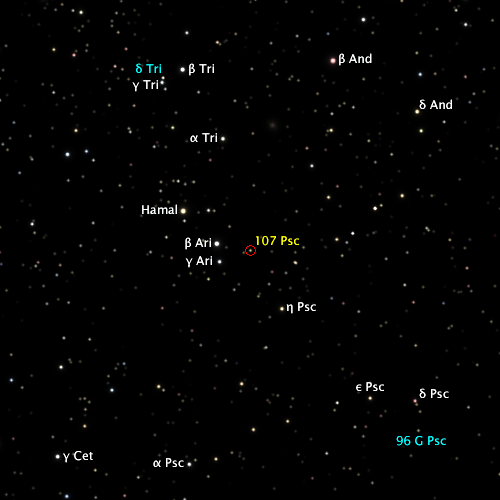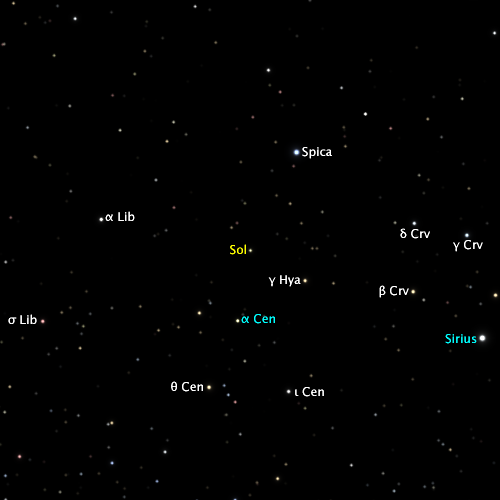as seen from Sol.
107 Piscium.


| Right Ascension | 01h 42m |
|---|---|
| Declination | +20° 16' |
| Distance | 24.39 ± 0.16 ly |
| Spectral Class | K1V |
| Estimated Mass | 0.80 × Sol |
| Luminosity | 0.495 × Sol |
| 107 Piscium as seen from Sol. |
Sol as seen from 107 Piscium. |
|---|---|
 |
 |
| Star | Magnitude | Distance |
|---|---|---|
| Canopus | −0.60 | 312.2 |
| Alpha Aurigae (Capella) | −0.48 | 33.1 |
| Rigel | 0.15 | 850.6 |
| Aldebaran | 0.28 | 50.8 |
| Achernar | 0.40 | 136.3 |
| Betelgeuse | 0.40 | 487.0 |
| Beta Centauri (Hadar) | 0.71 | 411.1 |
| Vega | 0.75 | 34.9 |
| Alpha Crucis (Acrux) | 0.89 | 339.9 |
| Sirius | 0.89 | 25.0 |
| Arcturus | 0.93 | 57.7 |
| Destination | Distance |
|---|---|
| 96 Piscium | 8.5 |
| Delta Trianguli | 13.4 |
| Eta Cassiopeiae A | 15.4 |
| Kappa1 Ceti | 14.5 |
Planets orbiting 107 Piscium are named after gods and titans from Ancient Greek mythology.
| Planet | SMA (AU) |
Orbital Period |
e | Equatorial Diameter (km) |
Mass (Earths) |
Density (g/cm3) |
Gravity (Earth g) |
Atmospheric Pressure (Earth=1) |
Sidereal Day |
Mean Solar Day |
Axial Tilt |
Known Moons |
|---|---|---|---|---|---|---|---|---|---|---|---|---|
| Hades | 0.07855 | 8.9957 d | 0.0007 | 4451 | 0.05329 | 6.89 | 0.4374 | 0.0 | 8d 23h 53.8m | Synchronous | 00° 01.3' | 0 |
| Crius | 0.4038 | 104.84 d | 0.0225 | 7721 | 0.1623 | 4.02 | 0.4427 | 0.0000930 | 104d 20h 04.4m | Synchronous | 00° 02.5' | 0 |
| Oceanus | 0.6478 | 213.07 d | 0.0131 | 13730 | 1.226 | 5.43 | 1.058 | 5.32 | 21h 18.1m | 21h 23.5m | 07° 36.9' | 1 |
| Theia | 1.043 | 1.1919 y | 0.0150 | 9392 | 0.3271 | 4.54 | 0.6030 | 0.275 | 15h 48.9m | 15h 50.3m | 31° 56.4' | 2 |
| Phorcys | 1.794 | 2.6881 y | 0.0795 | 10530 | 0.4208 | 4.11 | 0.6172 | 1.61 | 4d 07h 15.9m R | 4d 06h 48.9m | 158° 58.1' | 1 |
| Diastima | 6.379 | 18.023 y | 0.0694 | 129800 | 171.2 | 0.937 | 1.652 | &mdash | 16h 51.6m | 16h 51.7m | 18° 53.2' | 14 |
| Khronos | 21.80 | 113.89 y | 0.2734 | 154500 | 749.5 | 2.37 | 5.106 | &mdash | 14h 36.1m | 14h 36.2m | 39° 15.5' | 18 |
| Name | Diameter (km) |
Period (days) |
Semimajor Axis (km) |
Ecc | Inc |
|---|---|---|---|---|---|
| Natural Satellites of Oceanus | |||||
| Oceanus I | 14 | 10.19 | 212500 | 0.0733 | 0.98 |
| Natural Satellites of Theia | |||||
| Theia I | 124 | 3.148 | 62520 | 0.0034 | 0.83 |
| Theia II | 29 | 5.344 | 88970 | 0.0356 | 1.43 |
| Natural Satellites of Phorcys | |||||
| Phorcys I | 89 | 6.599 | 111400 | 0.0265 | 7.21 |
| Natural Satellites of Diastima | |||||
| Diastima I | 628 | 0.8108 | 204000 | 0.0017 | 0.12 |
| Diastima II | 479 | 1.099 | 249800 | 0.0064 | 0.59 |
| Diastima III | 3437 | 1.647 | 327100 | 0.0288 | 1.07 |
| Diastima IV | 4148 | 3.281 | 518000 | 0.0029 | 0.67 |
| Diastima V | 743 | 4.919 | 678500 | 0.0115 | 2.29 |
| Diastima VI | 861 | 6.649 | 829500 | 0.0318 | 2.38 |
| Diastima VII | 622 | 11.35 | 1185000 | 0.0639 | 4.39 |
| Diastima VIII | 312 | 17.06 | 1555000 | 0.0442 | 0.98 |
| Diastima IX | 63 | 28.52 | 2190000 | 0.0641 | 8.84 |
| Diastima X | 54 | 33.67 | 2446000 | 0.0236 | 13.68 |
| Diastima XI | 45 | 63.51 | 3734000 | 0.1909 | 29.54 |
| Diastima XII | 28 | 90.77 | 4738000 | 0.2271 | 144.55 |
| Diastima XIII | 26 | 125.8 | 5891000 | 0.0130 | 34.44 |
| Diastima XIV | 19 | 200.2 | 8029000 | 0.2264 | 165.08 |
| Natural Satellites of Khronos | |||||
| Khronos VIII | 45 | 0.7070 | 304500 | 0.0252 | 0.63 |
| Khronos IX | 154 | 1.122 | 414300 | 0.0064 | 0.42 |
| Khronos X | 137 | 1.722 | 551400 | 0.0086 | 0.63 |
| Khronos IV | 851 | 2.138 | 636800 | 0.0022 | 0.95 |
| Khronos I | 4263 | 3.190 | 831500 | 0.0043 | 0.77 |
| Khronos II | 7692 | 6.380 | 1320000 | 0.0028 | 0.57 |
| Khronos III | 4940 | 12.76 | 2095000 | 0.0027 | 0.29 |
| Khronos V | 877 | 18.76 | 2709000 | 0.0036 | 1.03 |
| Khronos VI | 1248 | 24.91 | 3273000 | 0.0352 | 1.16 |
| Khronos VII | 682 | 31.90 | 3860000 | 0.0420 | 1.51 |
| Khronos XI | 167 | 58.80 | 5802000 | 0.0259 | 3.51 |
| Khronos XII | 77 | 80.91 | 7178000 | 0.0463 | 34.10 |
| Khronos XIII | 123 | 125.4 | 9616000 | 0.1445 | 34.43 |
| Khronos XIV | 77 | 151.9 | 10930000 | 0.2736 | 21.19 |
| Khronos XV | 47 | 328.6 | 18270000 | 0.1000 | 169.84 |
| Khronos XVI | 33 | 451.5 | 22580000 | 0.3731 | 41.61 |
| Khronos XVII | 22 | 973.1 | 37680000 | 0.4142 | 143.13 |
| Khronos XVIII | 20 | 1803 | 56840000 | 0.5585 | 66.37 |
Hades is a hot, airless, heavily-cratered world the size of Mercury orbiting in close proximity to its sun. Hades is very dense with a density of 6.894. It has a very large iron-nickel core that is believed to take up more than 80% of the volume of the planet. Hades is rich in resources but its close proximity to its sun make it a challenging world to mine.
Like most planets close in to their stars, Hades is tidally locked to its sun with permanent day and night sides. The day side of Hades bakes at up to 1,000K at the subsolar point while the night side can have a temperature as low as 6K.
Crius is a planet slightly larger than Mars with a tenuous atmosphere. The planet once possessed a substantially thicker atmosphere, but much of the atmosphere has been stripped away by the solar wind. The atmosphere then condensed on the cold side and the remaining atmosphere consists of a few heavy gases like krypton with low boiling points.
Oceanus is a world with a global ocean. Although the ocean covers the whole planet, in places the ocean is not very deep and in a few places the seabed lies only about 100 metres below the surface of the ocean. Oceanus is a life-bearing planet with a diverse range of unicellular organisms.
Oceanus Base is a planetary settlement located near the equator, in one of the shallow parts of the global ocean. It is a mushroom-shaped structure above the surface of the ocean, with additional facilities on the seabed. At Oceanus Base, researchers study the lifeforms and oceanography of the ocean planet.
Theia is a world with a remnant ocean that is frozen solid. There are signs that the global ocean undergoes periodic thawing, but no sign that it has done so recently. It is not known if this world is life-bearing.
Phorcys is a world of about half an Earth mass covered in a global glacier. The world has an unusually slow rotation that is also retrograde.
Diastima is a gas giant with half the mass of Jupiter, a somewhat smaller radius and a similar appearance. It is named for the Greek word for space.
Khronos is a gas giant twice as massive as Jupiter in a somewhat eccentric orbit. It is named for the Greek word for time.